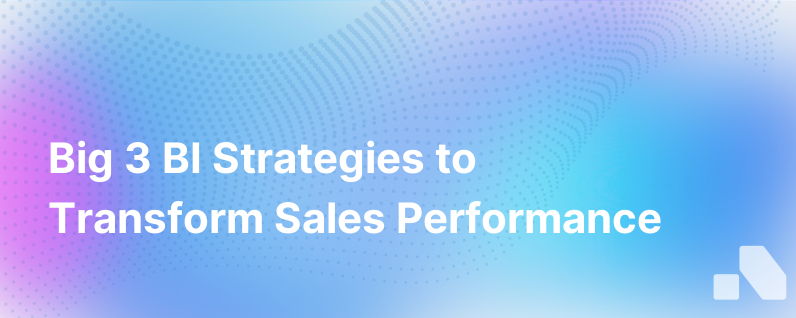Bi And Sales The Big 3 In Bi For Sales Collect Analyze Act
Published on October 16, 2023 by David Zhang
Unleashing the Power of BI in Sales: The Big 3 - Collect, Analyze, Act
In the realm of modern sales and business development, data rules supreme. No longer is sales merely an art; it is now incontrovertibly a science—a science powered by Business Intelligence (BI). At its heart, BI in sales is about harnessing data-driven insights to make informed decisions and drive sales strategy. The process can be distilled into a three-step mantra for sales success: Collect, Analyze, and Act—the Big 3 of BI for sales.
The Age of Data-Driven Sales
In past decades, sales was largely predicated on intuition and personal experience. Today's sales environment, however, demands a transition from gut feelings to actionable insights. The competitive landscape has tilted in favor of those who can adeptly navigate the vast ocean of data available. Leveraging BI allows sales teams to understand their market better, anticipate customer needs, craft superior strategies, and ultimately close more deals.
The Big 3 of BI for Sales
Let's dissect the essential stages of BI in the sales process and understand how they form the backbone of a successful sales operation.
1. Collect – The Foundation of Intelligence
Data is the fundamental currency of BI. The process begins with collection—the gathering of raw data from various sources. Sales data can come from multiple touchpoints: customer interactions, CRM systems, social media engagements, website analytics, transaction records, and more.
However, the collection is more than compiling numbers; it's about ensuring data quality, relevance, and consistency. It's crucial to have information that is up-to-date and accurate. Advanced data management tools can aid in this endeavor by aggregating, cleaning, and preparing data for analysis. They allow sales teams to not only amass but organize data into manageable and coherent datasets ready for the next BI phase.
2. Analyze – Gleaning Actionable Insights
Once you've amassed data, the next step is to extract meaning from it. Analysis is where the magic of BI truly happens. Sophisticated algorithms and models assess the collected data to discern patterns, trends, and correlations. This step is pivotal in transforming raw data into insights that can direct business strategies.
For sales teams, analysis provides a granular view of sales performance metrics, customer purchase behavior, market trends, and potential growth opportunities. Using BI tools, you can delve into questions like: Which customer segments are most profitable? Which products are top-selling? What factors influence purchase decisions? The analytical engines within BI software can predict customer churn, forecast sales, and identify up-sell and cross-sell opportunities, providing an edge to sales strategists.
3. Act – Making the Insights Count
The ultimate value of BI lies in the actions it enables. Data-driven insights are only as good as the decisions they inform. This phase is about turning intelligence into practical strategies and tactics. It's decision time—where all the collected and analyzed data are brought to bear on sales operations.
Armed with robust insights, sales leaders can determine where to focus their efforts—be it developing specific regions, targeting key accounts, customizing offerings, refining sales pitches, or optimizing the sales funnel. BI does not only aid in strategic decision making but also in tactical maneuvers. It informs individual sales reps which prospects to focus on, which leads are most likely to convert, and even the best times to reach out to potential clients.
Sales actions can also include employing customized content and personalized engagements, informed by the nuanced understanding of customer profiles that BI provides. As sales teams act on these insights, they create feedback loops that, in turn, generate more data, feeding into a continuous cycle of improvement fostered by BI.
Integration of BI into Sales Culture
To derive the full benefit of BI, it needs to be woven into the fabric of a company's sales culture. Every team member, from the front-line sales representatives to top management, should be empowered to leverage BI insights. Training and accessibility are key factors to ensure the adoption of BI tools across the organization.
The Role of Advanced Technologies
The integration of advanced technologies into BI tools, such as artificial intelligence (AI) and machine learning, greatly enriches the BI process. AI-driven BI tools can automate routine data analysis, uncover deeper insights, provide real-time analytics, and even offer predictive recommendations. The technological evolution in BI tools is an ongoing process, constantly expanding the capabilities and potential of sales teams.
Leveraging BI for Sustained Growth
Ultimately, BI is a means to an end—the strategic growth of the business. By meticulously following the Big 3—Collect, Analyze, and Act—sales teams can ensure that their efforts are not just diligent but also smart. This systematic approach enables teams to respond dynamically to market changes, anticipate customer needs, and maintain a competitive advantage in a data-driven market.
Conclusion
The journey of BI in sales is cyclical and constantly evolving. Armed with the right tools and mindset, sales professionals can harness the power of BI to not just reach their targets but to shatter them. It's about building a culture that values data and analytics as much as it does relationships and expertise. In the era of big data, the winning sales teams will be those that can adroitly navigate the troika of Collect, Analyze, and Act. As BI technologies continue to advance, the possibilities for their application in sales will only grow, promising a future where data analysis is as integral to sales as the pitch itself.